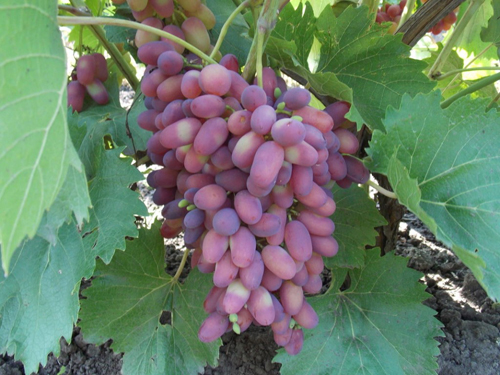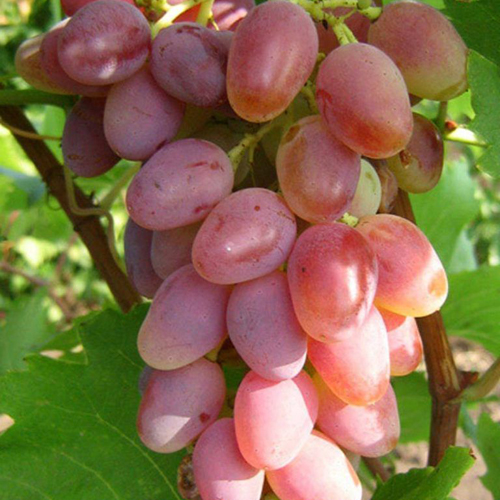Arched grape variety
Arched is a table grape variety of domestic selection. Bred at the Novocherkassk Scientific Research Institute of Viticulture and Winemaking named after V.I. ME AND. Potapenko by crossing a complex hybrid named Intervitis Magaracha with the Druzhba variety. For its origin, it also received the unofficial name of Friendship pink, and in some cases it is also known under the name Tsvetnoy.
Distinctive qualities of the variety are high vigor, early maturity, good and stable yield, attractive appearance of bunches, relative resistance to diseases and low winter temperatures. However, despite such a set of advantages, the form did not receive wide distribution. Many amateurs did not like the overly simple taste of grapes, and the most picky critics added to the shortcomings not too, in their opinion, a large bunch, and a large number of seeds contained in the berries. In the eyes of a significant number of winegrowers, these flaws completely negate all the positive qualities of the variety. And, nevertheless, he continues to meet in the plots and be respected by those growers who put the simplicity of plants in the first place, and already in the second place pay attention to the gastronomic properties of its fruits.

Agrobiological characteristics
Arched bushes grow powerful, with thick, vigorous shoots. The crown is densely pubescent, greenish-gray. Young leaves are wrinkled, have a pronounced burgundy pigmentation. Typical leaf is large, rounded or somewhat stretched in width, five-lobed, moderately dissected. The surface of the grape leaf is reticulate-wrinkled, green with slightly pinkish veins. Top side cutouts of medium depth, slotted or V-shaped. The lower incisions are barely marked or absent. The petiolate notch is predominantly vaulted with a pointed bottom or lancet. The petioles are comparable in length to the main vein of the leaf, colored green with longitudinal red stripes. A similar color is typical for the shoot axis. The teeth along the perimeter of the leaf blade are relatively uniform in size, triangular and saw-shaped with straight edges and sharp tops. The flowers are bisexual, which guarantees good pollination and the absence of pea berries. Inflorescences and ovaries do not crumble. The vine ripens very well and practically to its full length. After that, the shoots turn brown.
The size of the grape bunches is above average, the shape is cylindrical, the density is high. The average weight of a ripe brush of the Arched is 400-600 grams. The combs are of medium length, strong, herbaceous, but often lignified at the base. The berries of the variety are rather large, oval-nipple-shaped, 23-26 mm long and 17-19 mm in diameter in the wide part. The grapes are very aligned, close to each other in bunches, due to which their deformation can sometimes be noted. Half, and often entirely, the berries are colored pink, with good lighting turning into red, covered with a dense layer of pruin. The weight of 100 grapes is 500-600 grams. The strength of the ridge attachment is average. The pulp is dense, fleshy, as if marmalade, with a neutral, usually not too expressive taste, and the absence of varietal aroma. The juice is colorless, sugar content 16-18%, with a low titratable acidity of 4-5 g / l. The skin is not too thick, firm, but edible. When eating, bones can cause some discomfort, which does not add to the fruits of gastronomic sophistication. The overall grape tasting score does not exceed 7.7 points.
The crop is intended for use in fresh food, however, due to its modest taste characteristics, it does not cause much delight among consumers.At the same time, due to the attractive appearance of the bunches and unpretentiousness in cultivation, Archny can arouse a certain interest among farmers who cultivate it for sale. Another positive feature is the excellent transportability of the bunches, due to which transportation even over long distances does not impair their presentation. Among amateurs who grow grapes for their own needs, the variety is rarely found, however, here you can also find good options for using the resulting crop. In particular, dense, beautiful berries are perfect for all kinds of home preservation - compotes, preserves, marinades, which will become an excellent source of vitamins in winter. In addition, neatly collected bunches show good keeping quality, and can be stored in cold cellars with an optimal humidity level for a long time.

An unambiguous positive quality of Archnoye is its early maturity. He only needs 115-120 days, counting from the moment the buds bloom, in order for the bunches to reach removable ripeness. In the south, readiness for mass harvesting of grapes begins by mid-August, and during this time the sum of active temperatures reaches 2350-2450 ° C. These indicators indicate the possibility of promoting the variety in non-traditional regions for viticulture. This fact is also confirmed by the growers who cultivate it in central Russia, throughout the territory of Ukraine and the south of Belarus. The increased frost resistance characteristic of our hero (-25 ° C) is also a positive moment when expanding the geography of its distribution. Not everywhere, of course, it can be grown without shelter for the winter, but even where this procedure is required, it will be much less laborious compared to the insulation of varieties unstable to frost.
Another strong point of our hero is the high yield, which is quite stable over the years. The bushes hold the load well, and therefore up to 30 kilograms of bunches from the bush ripen at standard times, and the plants do not show signs of oppression. Good productivity of grapes is facilitated by such parameters as a large percentage of fruiting shoots - 65-80% and an excellent fertility rate - 1.5-1.8. Even the shoots that have developed from the lower buds are fruitful, which makes pruning and other operations to normalize the load quite easy and understandable even for a novice winegrower. By the way, due to the not too high large-fruited variety, on the strong shoots of Archny, which can reach 4-6 meters in length, you can leave two bunches at once without the risk of provoking a lack of plastic substances to achieve the desired conditions. A certain overload is possible only with the most abundant harvests on those bushes that are cultivated in conditions of a low agricultural background and insufficient care for them.
In good weather, ripe grapes can remain hanging on the vine for a long time, without losing moisture and without raining. But in the event of rainy weather, and especially with a sharp drop in soil moisture, when the rains come after a prolonged drought, cracking of the berries is possible, which spoils the presentation of the bunches and contributes to their decay. In addition, if intact grapes are not usually the subject of interest on the part of wasps and hornets, then at the very first signs of "cracking" of berries, a mass of insects rush to them, which cause even greater damage to the crop.
Agrotechnical features
From the point of view of cultivation technology, Archny is quite unpretentious, due to which there should not be any particular difficulties in caring for it.
Planting should follow the general rules for most grape varieties.First of all, it is necessary to assess the suitability of the existing site for the cultivation of this culture. First of all, this concerns heat supply. If in the southern regions both flat places and slopes of various exposures, with the exception of the coldest ones, are suitable for an early maturing variety, then as you move north, the requirements will become more stringent. In areas with the most modest level of SAT, where in cool seasons there is a risk of insufficient crop maturation, the bushes are placed strictly in the upper parts of the southern slopes, or they provide protection from cold winds by planting from the sunny side of various buildings or fences, in the so-called "wall" culture. The general rule for all grape-growing areas is that lowlands and gullies are unsuitable for it, as well as places with a high level of groundwater, too damp, and even more so swampy areas.
In areas free from root phylloxera, the breeding of the variety will not be difficult even for a beginner winegrower, since its cuttings root well, grow quickly and enter fruiting. However, where a malicious soil pest has already settled, this planting method will not work due to the instability of the Arched to root aphids. In this case, it is necessary to use seedlings, for which phylloxera-resistant forms of grapes are taken as rootstocks. Our hero has excellent fusion with most of them. A sufficient area of land is allocated for vigorous bushes to prevent future competition with neighbors and mutual oppression.
From the first years after planting, especially fast-growing self-rooted plants, you need to start forming them, which is chosen depending on the local climate and, first of all, its frost hazard. The ideal option for Archnoye will be high-stem non-covering formations, and even better is the cultivation of the variety in the arbor culture, which is possible only where the thermometer in winter is guaranteed not to fall below the -25 ° C mark. If there is a risk of freezing, then the aboveground part of the plants will have to be covered for the winter. For this, the vine bushes are shaped like a multi-arm fan or an inclined cordon, which allows the vine to be removed annually from the trellis without damaging it.
Fruiting plants can be cut rather shortly (3-4 eyes), due to the productivity of the buds at the base of the fruit arrows. In general, the bushes are usually loaded with 30-40 eyes, but this figure can vary both up and down, depending on the cultivation conditions. After the beginning of the growing season, a fragment of weak and sterile shoots is necessarily carried out, but you can refrain from thinning the number of inflorescences, if their number does not exceed two per shoot.
The variety is moderately resistant to fungal diseases such as powdery mildew and gray rot, but it resists mildew well. This makes it possible to do 3-4 spraying of grapes with fungicides per season, with an emphasis on counteracting the first two diseases. Lightening the bunches to allow air and sunlight to access them also works well against gray mold. The same procedure enhances the attractiveness of the color of the ripening Arcochny berries.








